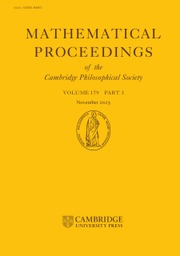A quotient ordered space
Published online by Cambridge University Press: 24 October 2008
Extract
It is well known that, in the study of quotient spaces it suffices to consider a topological space (X,  ), an equivalence relation R on X and the projection mapping p: X → X/R (where X/R is the family of R-classes of X) defined by p(x) = Rx (where Rx is the R-class to which x belongs) for each x ∈ X. A topology
), an equivalence relation R on X and the projection mapping p: X → X/R (where X/R is the family of R-classes of X) defined by p(x) = Rx (where Rx is the R-class to which x belongs) for each x ∈ X. A topology  may be defined for the set X/R by agreeing that U ⊆ X/R is
may be defined for the set X/R by agreeing that U ⊆ X/R is  -open if and only if p-1 (U) is
-open if and only if p-1 (U) is  -open in X. The topological space
-open in X. The topological space  is known as the quotient space relative to the space
is known as the quotient space relative to the space  ) and projection p. If
) and projection p. If  (or simply
(or simply  ) since the symbol ≤ denotes all partial orders and no confusion arises) is a topological ordered space (that is, X is a set for which both a topology
) since the symbol ≤ denotes all partial orders and no confusion arises) is a topological ordered space (that is, X is a set for which both a topology  and a partial order ≤ is defined) then, providing the projection p satisfies the property
and a partial order ≤ is defined) then, providing the projection p satisfies the property

a partial order may be defined in X/R by agreeing that p(x) < p(y) if and only if x < y in x. The topological ordered space  is known as the quotient ordered space relative to the ordered space
is known as the quotient ordered space relative to the ordered space  and projection p.
and projection p.
Information
- Type
- Research Article
- Information
- Mathematical Proceedings of the Cambridge Philosophical Society , Volume 64 , Issue 2 , April 1968 , pp. 317 - 322
- Copyright
- Copyright © Cambridge Philosophical Society 1968
References
REFERENCES
- 2
- Cited by

